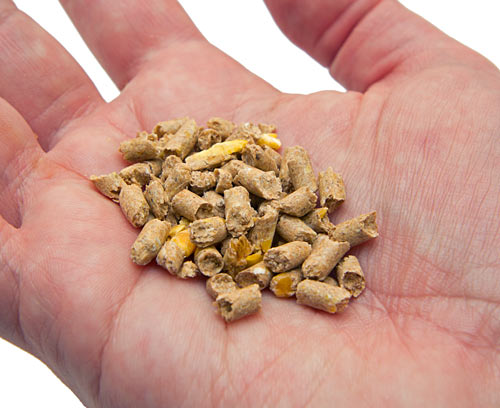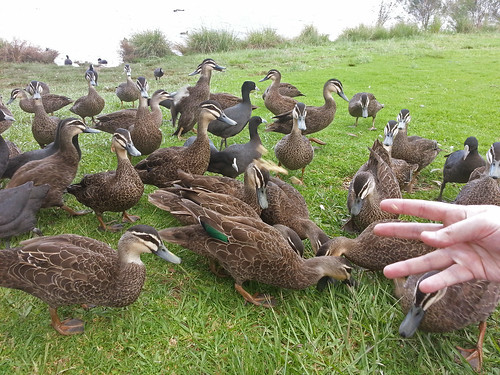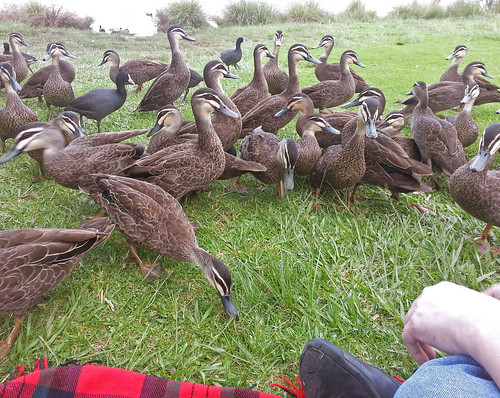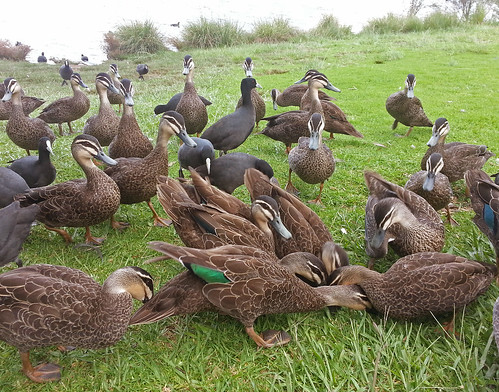Bread is not good for birds. It's not deadly poison for most of the wild birds that humans commonly feed, but it's basically empty carbohydrates. Wild birds usually have plenty of opportunities to burn off calories, but it's still a better idea to feed them something that more closely resembles what they naturally eat.
(Conservationists usually argue that the best thing to feed to wild birds is nothing, to prevent stress and injuries from squabbling over an unnatural pile of food, dependence on humans, and over-breeding. But screw you, I like feeding birds.)
There's also that possible canard, ha ha, that says if a duck eats dry bread and then has a drink, the bread can swell in its throat and choke it, so you should always chuck your duck-bread in the water and not on dry land. I find this more plausible than feeding Alka-Seltzer to pigeons in order to cause them to explode, but I imagine there'd be pretty strong selective pressure against ducks living in human settlements who choke on bread.
In any case, I resolved to attempt to kill some ducks with astonishment, by feeding them something that's actually moderately good for them.
I got a degree on this subject from an intensive five-minute study program at the University of Google. Then, when I next went to pick up twenty tons of seed for the cockatoos from the local farm-stuff shop, I also bought a bag of "layer pellets".
Layer pellets are feed for egg-producing chickens. They're a compound feed made from various grains and maize and suchlike, generally with a lot of calcium, for eggshells.
Naturally, ducks like the Pacific Black Ducks at my nearest good-sized lake dabble around on the bottom of the lake with their tails pointing up ridiculously, and eat water-plant seeds, along with the occasional insect or snail or bits of plant matter they can find both in the water and on land.
(Digression: If you'd like to identify some bird you just saw in Australia, the Birds in Backyards Bird Finder is a good first stop. They even have a page for the emu, which makes me wonder if anybody has actually ended up there from the Bird Finder, after perhaps attempting to determine whether the six-foot fluffy dinosaur in their back yard is some kind of pigeon. Perhaps someone has at some point needed to determine whether the looming thing in their back yard is an emu or a casssowary.)
You can get various other prepared food mixtures for poultry, like "grower pellets" for instance; those have more protein and fat, to build meat fast. (There's also "mash", which is just the ingredients mixed together and not pressed into pellets.)
Layer pellets seem a pretty natural kind of food for ducks, though. There's endless debate over what people who keep ducks of their own should feed them, and of the niceties of wild-animal food intake in a world that contains humans tossing stale bread and rubbish bins full of fascinating stuff for animals equipped to fish it out. But layer pellets, for ducks, certainly seem to be close enough for government work.
I tried one of the pellets myself. If you were to draw a Breakfast Cereal Nutrition Versus Flavour graph with the X axis for "healthiness" and Y for "flavour", corn flakes might score something like 5 and 6 respectively, and Frosted Flakes of Nothing would score 1 and 8. Layer pellets taste like a cereal that would score 10, and 0.2.
Would the ducks like them more than I did? Would they even recognise these things as food?
Yep, looks like it.
Both the ducks and the eurasian coots that inhabit Wentworth Falls Lake were entirely delighted with the layer pellets.
(The coots, by the way, have extraordinary feet.)
The pellets are denser than water. If I threw them in the lake then I suppose the ducks might dabble them up again, but it was more fun to just scatter food near our picnic blanket. Ducks' beaks were stabbing away at the ground like little pneumatic drills.
They were even almost brave enough to eat pellets from my hand, but all any of them ever actually managed was a vague bite at the end of one of my fingers. No part of a duck seems to be particularly pointy, so I was in no danger of...
...what happens when a cockatoo decides to perch on my arm.
(I tried layer pellets on the cockatoos, too. They were very confused. One scattered the little pile of pellets with his beak to see if there was some actual food underneath.)
All in all, a very successful day out. Layer pellets aren't expensive, either. Highly recommended.





18 February 2013 at 12:55 pm
Hah! This bit in particular elicited a nice chuckle:
"I got a degree on this subject from an intensive five-minute study program at the University of Google."
I needed that laugh. Thanks!
PS: that's probably the nicest photo of layer pellets I've seen. I can almost taste them (or not, as the case may be)!
18 February 2013 at 2:17 pm
Love the pics. Feel bad about all the cheap white bread I bought for my college ducks.
Link to "extraordinary feet" doesn't work for me.
--Me
18 February 2013 at 2:58 pm
Fixed now. Thanks!
18 February 2013 at 6:14 pm
"If you were to draw a Breakfast Cereal Nutrition Versus Flavour graph with the X axis for "healthiness" and Y for "nutrition", corn flakes might score something like 6 and 5 respectively, and Frosted Flakes of Nothing would score 8 and 1. Layer pellets taste like a cereal that would score 10, and 0.2."
It's entirely possible that I'm just too slow for reading comprehension off the back of a sleepless weekend, but I am not understanding that graph at all. Should one of the axes be "tastiness" or something?
18 February 2013 at 7:47 pm
You're quite right! Fixing it.
19 February 2013 at 5:16 am
One of the reasons not to feed birds a lot of bread is that it can cause Angelwing disease. Basically the high amounts of fat and sugar causes their bones to become deformed and brittle. Called angelwing because it deforms their wings so they can't properly fold them up and they stick out. We rescued a gallah from an old guy who fed it nothing but sunflower seeds, chocolate and toast. He couldn't fold his wings, couldn't walk properly because of multiple broken legs, an X-ray showed he'd had dozens of healed minor breaks throughout his wings.
But, that's an extreme case, I don't think bread in moderation is a problem for wild birds. :)